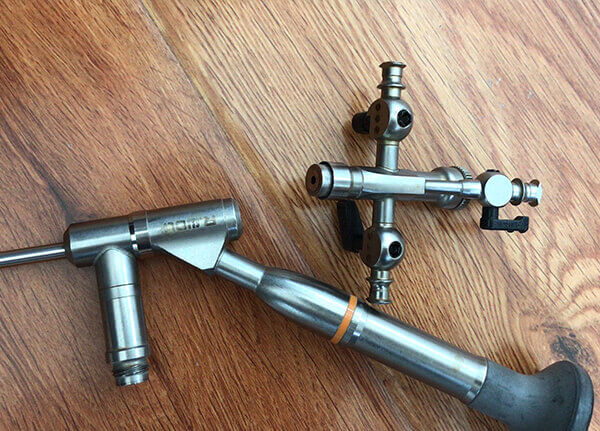欢迎来到匠仁医疗设备有限公司网站!

内窥镜作为现代医疗领域不可或缺的精密设备,凭借其深入人体内部进行可视化诊断与手术的特性,极大推动了微创医疗的发展。然而,当这类设备出现故障时,维修过程却面临着重重技术难关。从设备的精密结构到特殊材料应用,从复杂的成像系统到严苛的卫生标准,每一个环节都对维修技术提出了极高要求。
Endoscope, as an indispensable precision equipment in modern medical field, has greatly promoted the development of minimally invasive medicine due to its ability to visualize diagnosis and surgery inside the human body. However, when such equipment malfunctions, the repair process faces numerous technical difficulties. From the precise structure of the equipment to the application of special materials, from complex imaging systems to strict hygiene standards, every aspect places extremely high demands on maintenance techniques.
精密复杂的内部构造是内窥镜维修的首要挑战。内窥镜通常集成了光学成像、照明、操控、管道传输等多个子系统,且需将这些功能部件压缩在直径数毫米至数厘米的细长镜身内。例如,硬性内窥镜的光学镜头组由多片不同曲率的镜片精密组装而成,镜片间距、角度误差需控制在微米级别,稍有偏差就会导致图像模糊、畸变。软性内窥镜则更为复杂,其内部的导光束、导像束由数万根极细的光纤组成,每根光纤都需保持完好,一旦出现断裂或错位,就会在图像中形成黑点或干扰条纹。维修时不仅要精准定位故障部件,更要在狭小空间内完成拆解与组装,稍有不慎就可能造成二次损坏。
The precise and complex internal structure is the primary challenge in endoscopic maintenance. Endoscopes typically integrate multiple subsystems such as optical imaging, illumination, manipulation, and pipeline transmission, and these functional components need to be compressed into a slender mirror body with a diameter of several millimeters to several centimeters. For example, the optical lens group of a rigid endoscope is precisely assembled from multiple lenses with different curvatures, and the lens spacing and angle errors need to be controlled at the micrometer level. A slight deviation can lead to image blurring and distortion. Soft endoscopes are even more complex, with their internal light and image guide beams composed of tens of thousands of extremely thin optical fibers, each of which needs to be kept intact. Once broken or misaligned, black spots or interference fringes will form in the image. When repairing, it is not only necessary to accurately locate the faulty components, but also to complete disassembly and assembly in a small space. A slight mistake may cause secondary damage.
核心部件的特殊材料与精细工艺进一步增加了维修难度。内窥镜的镜头、光纤、外鞘管等关键部件,均采用特殊材料以满足医用标准。镜头的光学玻璃需具备高透光率、低色散特性,且表面经过多层镀膜处理,以增强光线传输效率和抗刮耐磨性能;光纤材质对纯度要求极高,任何杂质都可能影响图像质量。此外,软性镜身的外皮采用医用级高分子材料,既要保证柔韧性便于插入人体,又要具备良好的生物相容性和耐腐蚀性。维修过程中,若需要更换这些部件,不仅要找到材质、规格完全匹配的替代品,还需采用激光焊接、微组装等特殊工艺进行安装,而这些技术对操作人员的经验和设备精度要求都极为苛刻。
The special materials and fine craftsmanship of the core components further increase the difficulty of maintenance. The key components of the endoscope, such as the lens, optical fiber, and outer sheath, are all made of special materials to meet medical standards. The optical glass of the lens needs to have high transmittance and low dispersion characteristics, and the surface should be treated with multiple layers of coating to enhance light transmission efficiency and scratch and wear resistance; Fiber optic materials require extremely high purity, and any impurities may affect image quality. In addition, the outer skin of the flexible mirror body is made of medical grade polymer material, which not only ensures flexibility for easy insertion into the human body, but also has good biocompatibility and corrosion resistance. During the maintenance process, if these components need to be replaced, not only do we need to find substitutes with materials and specifications that match perfectly, but we also need to use special processes such as laser welding and micro assembly for installation, which require extremely strict experience from operators and equipment accuracy.

成像与控制系统的校准调试是维修技术的核心难点。现代内窥镜的成像系统已从传统光学成像发展为高清电子成像,涉及图像传感器、信号处理电路、数据传输等多个环节。当图像出现色彩失真、亮度不均等问题时,维修人员不仅要检查镜头、传感器是否损坏,还需对整个成像链路进行校准。例如,CMOS 图像传感器的参数调试需要专业的软件和设备,不同型号的传感器校准方法也不尽相同。操控系统的维修同样复杂,软性内窥镜的弯曲部由钢丝牵引控制,若出现弯曲角度异常或卡顿,需拆解镜身重新调整钢丝张力和滑轮结构,这一过程需要精确的计算和反复调试,才能恢复设备的灵活操控性能。
The calibration and debugging of imaging and control systems is the core difficulty of maintenance technology. The imaging system of modern endoscopes has evolved from traditional optical imaging to high-definition electronic imaging, involving multiple links such as image sensors, signal processing circuits, and data transmission. When there is color distortion and uneven brightness in the image, maintenance personnel not only need to check whether the lens and sensor are damaged, but also need to calibrate the entire imaging chain. For example, the parameter debugging of CMOS image sensors requires professional software and equipment, and the calibration methods for different types of sensors are also different. The maintenance of the control system is equally complex. The bending part of the flexible endoscope is controlled by steel wire traction. If there is an abnormal bending angle or jamming, the endoscope body needs to be disassembled and the steel wire tension and pulley structure need to be readjusted. This process requires precise calculation and repeated debugging to restore the flexible control performance of the equipment.
严格的卫生标准与质量验证为维修工作设置了最后一道关卡。内窥镜直接接触人体体腔,对卫生安全要求极高,维修后的设备必须通过严格的消毒灭菌流程,且不能因消毒处理影响性能。同时,维修完成后需进行全面的性能测试,包括图像清晰度、照明亮度、弯曲角度范围、器械通道密封性等多项指标,任何一项不达标都需重新排查维修。由于缺乏标准化的测试平台,不同型号内窥镜的测试方法和参数差异较大,维修人员需要根据具体设备特性制定个性化的检测方案,这无疑增加了维修工作的复杂性和不确定性。
Strict hygiene standards and quality verification have set the final hurdle for maintenance work. Endoscopes come into direct contact with the body cavity of the human body, which requires extremely high hygiene and safety requirements. After maintenance, the equipment must undergo strict disinfection and sterilization processes, and its performance cannot be affected by disinfection treatment. At the same time, comprehensive performance testing is required after the repair is completed, including multiple indicators such as image clarity, lighting brightness, bending angle range, and instrument channel sealing. If any of these indicators do not meet the standards, they need to be re inspected and repaired. Due to the lack of standardized testing platforms, there are significant differences in testing methods and parameters for different models of endoscopes. Maintenance personnel need to develop personalized testing plans based on specific equipment characteristics, which undoubtedly increases the complexity and uncertainty of maintenance work.
内窥镜设备维修是一项集光学、机械、电子、材料等多学科知识于一体的高难度技术工作。从攻克精密结构的拆装难题,到突破核心部件的工艺瓶颈;从掌握成像系统的调试技术,到满足严苛的卫生与质量标准,每一个环节都考验着维修人员的专业能力与技术水平。随着内窥镜技术的不断迭代升级,维修领域的技术挑战也将持续存在,唯有不断探索创新,才能确保这类精密医疗设备始终以最佳状态服务于临床医疗。
Endoscopic equipment maintenance is a highly challenging technical task that integrates knowledge from multiple disciplines such as optics, mechanics, electronics, and materials. From overcoming the difficulties of disassembling and assembling precision structures to breaking through the technological bottlenecks of core components; From mastering the debugging techniques of imaging systems to meeting strict hygiene and quality standards, every step tests the professional ability and technical level of maintenance personnel. With the continuous iteration and upgrading of endoscopic technology, technical challenges in the field of maintenance will continue to exist. Only by constantly exploring and innovating can we ensure that such precision medical equipment always serves clinical medicine in the best condition.
本文由内窥镜设备维修友情奉献.更多有关的知识请点击:http://www.jiangrenyiliao.cn我们将会对您提出的疑问进行详细的解答,欢迎您登录网站留言.
This article is a friendly contribution from the maintenance of endoscopic equipment For more information, please click: http://www.jiangrenyiliao.cn We will provide detailed answers to your questions. You are welcome to log in to our website and leave a message
 公司:匠仁医疗设备有限公司
公司:匠仁医疗设备有限公司 樊经理:13153199508 李经理:13873135765
公司地址:山东省济南市槐荫区美里东路3000号德迈国际信息产业园6号楼101-2室 湖南省长沙市雨花区劳动东路820号恒大绿洲14栋2409室
备案号:鲁ICP备2023027194号-1 鲁公网安备 37010402441281号